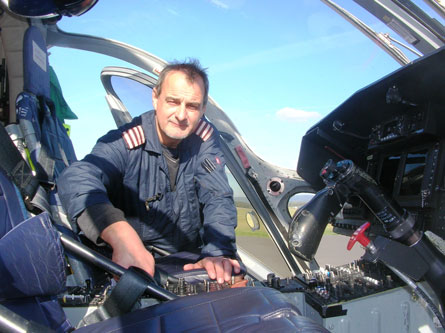Surrey and Sussex Air Ambulance pilot Steve Wood has a perhaps unique perspective on his sector of aviation, having once been rescued after an accident while racing a motorcycle on the Isle of Man
What sparked your interest in aviation?
My first flight in a helicopter was in an air ambulance, after an accident while racing a motorcycle on the Isle of Man, although I have no recollection of it. That's where my interest in aviation really began.
What was your career history before becoming a pilot?
I became a telephone engineer for BT after leaving school, then set up my own telecoms company, which enabled me to train for my private pilot's licence. In the 1990s I had a trial lesson in a helicopter. I was completely confused by it all, but decided that I wanted to fly for my career. I bought a 5% share in a Robinson R22, which helped me build hours toward my commercial licence.
Which jobs have you done as a helicopter pilot?
My first job was as an instructor at Redhill aerodrome [in Surrey]. I then had a spell flying Super Pumas over the North Sea, but the only exciting part was taking off and landing on the rig. I also worked for the Forestry Commission in Scotland, and with the National Grid during power line construction all over the UK, at times lowering engineers down to work with live lines; real precision flying. I then flew for the British Transport Police.
What attracted you to fly for an air ambulance service?
I suppose it was my rite of passage, having been airlifted all those years before. But it's the pinnacle for a pilot, as you get to land where you like, depending on the safety aspect. I also get to go home every night.
 |
|---|
© Kent, Surrey and Sussex Air Ambulance |
Describe a typical day
There is no typical day. I arrive at Dunsfold Park [Surrey] around 06:30, surf the net for weather reports and notice to airmen, then carry out aircraft and fuel checks, and, along with the medical crew, load the aircraft and check its weight and balance. We also have aircraft maintenance and general admin, and because we are a charity we have lots of visitors.
How demanding are your daily flight operations?
I really enjoy flying [MD902 Explorer] G-KSSH, she's very fast and slippery aerodynamically.The notar design adds to the quietness of the helicopter and helps with landing in confined areas, although I prefer a conventional tail rotor.
 |
|---|
© Kent, Surrey and Sussex Air Ambulance |
Fuel and payload are rarely an issue, and it's great for loading patients into the back. It's also got great visibility and the seats are very comfy, rare in helicopters. The landings are the most challenging tasks, as I have to negotiate with air traffic control and work out the best spot closest to the patient. Then we have to work with doctors and paramedics to decide which hospital is the most appropriate. Keeping control of a situation also requires diplomacy, compassion and empathy.
What are the best and worst things about your job?
I get real job satisfaction when the patients we airlift come to visit the base to say hello and thanks; it can be very emotional. But we're in the business of saving lives, and sadly on occasion for some people it isn't possible. Airlifting people to hospital when they don't make it can leave you numb.
How is the air ambulance operation funded?
The Air Ambulance service in Kent, Surrey and Sussex costs around £3.4 million ($5.5 million) annually to stay airborne. The charity relies almost entirely on the generosity of the public to support the two helicopters.
Find out more by visiting the Kent, Surrey and Sussex Air Ambulance website
Source: Flight International























